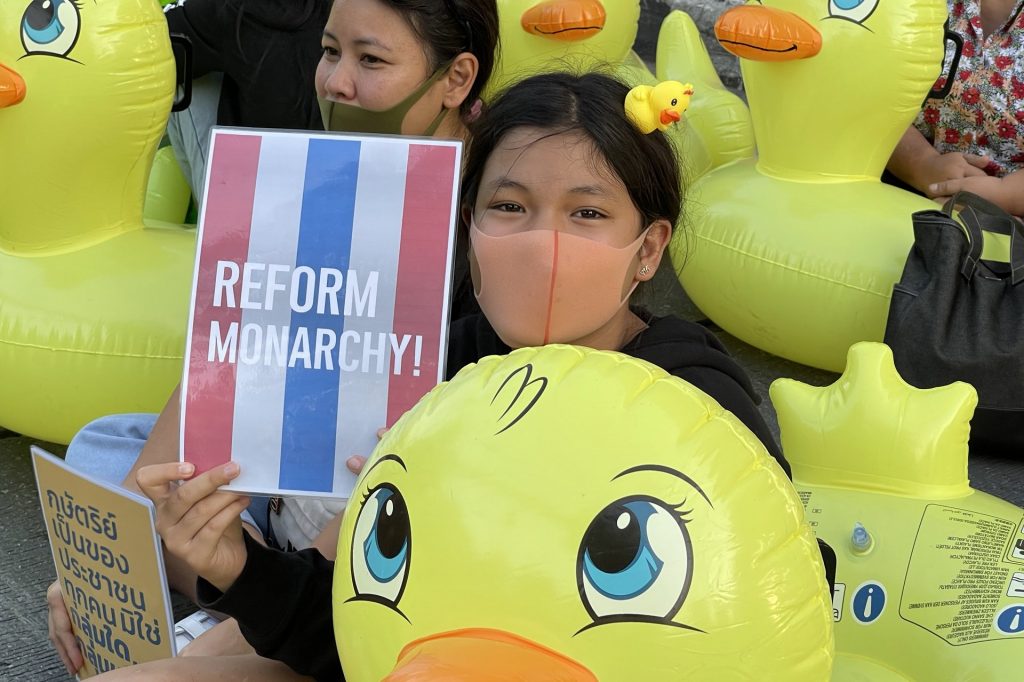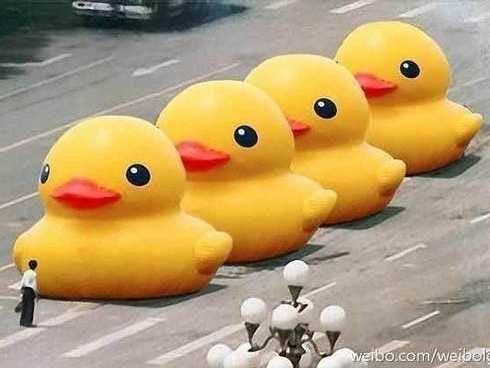Summary: The protests in Thailand which began in 2018 have continued to this day. The dissenters demanded that the pro-monarchy amendment made to the Crown Property Act be reverted. However, with the protests turning violent, the government and the police resorted to employ riot-control measures and many were jailed under the rarely used Lese Majesté Act.
Imprisonment of the protesters under this act has angered the dissenters who have added the removal of the act to their list of demands. Amid the commotion, the use of the yellow rubber ducks as a mascot for the protests has caught the worlds attention. While the involvement of foreign NGOs and companies have vitiated the atmosphere, the common citizens urge both the sides to take a step back and resolve the crisis while demanding the external entities do not meddle in the nation’s affairs.
Thailand is one of the few countries where monarchy is still in vogue. In Thailand, the government functions under both the monarchy and the Constitution. The king of the country and the prime minister elected by the people share power and rule. Maha Vajiralongkorn, also known as ‘Tenth Rama’, has been the king of the country since October 2016. Prayut Chan Oocha, who came to power through a military coup, is the Prime Minister at present.
It was after a year of the coup that protests began to grip Thailand. Since 2018, the protests have grown and spread to many towns and cities. The protests which started as a student-led movement have now seen the involvement of many opposition parties and common citizens. One of the prime demands of the protesters is the resignation of Prime Minister Ochha and the enactment of a new constitution. The demands include bringing in reforms in the monarchy which will ensure the reduction of the powers of the monarch.
The trigger for the protest in 2018, as the amendment to the Crown Property Act which allowed the King Maha Vajiralongkorn to transfer billions of dollars’ worth of royal assets traditionally held by the Thai Crown directly into his control. Shares at various Thai conglomerates like the Siam Commercial Bank and Siam Cement Public Company were registered in the King’s name. The transfer made him one of the world’s richest monarchs. These sweeping amendments in favor of the king made the protesters to demand an investigation into the Act and King’s financial actions. They began to demand greater transparency and public oversight of the royal budget.
However, the most recent protests that began in November 2020 came almost two weeks after Thailand’s Parliament rejected a proposal to amend the constitution that could have paved the way for monarchical reform. Instead, the joint chamber voted to move forward on two proposals for constitutional reform that didn’t touch changes to the monarchy.
A state of emergency was declared on November 15th as the capital city of Bangkok was overwhelmed by large-scale protests. As the government and the forces continue to quash the protests, the protesters continue to pour into the city despite the declaration of emergency. The protests, which were largely peaceful until a few months ago, have turned violent after lock-down due to the Corona pandemic was lifted. Massive violence erupted last week when hundreds of students rallied in front of parliament.
The law used to arrest the protesters has caused further anger among the people. The Thai police have been arresting protesters under the law called ‘ Lèse majesté’,under which anyone who speaks out against the royal family could face up to 15 years in prison. Anyone other than the royal family and government officials can file a complaint against someone under this Act. Protesters allege that this law has been used mostly by the ruling politicians for vendetta and to settle personal scores. Though the law had not been used much during the last few years and not many cases were registered, the use of the same law by the police to arrest the protesters and suppress the protests has rankled the citizens.
The police have filed cases against several student leaders and groups for insulting the monarchy under the Lese Majesté Act.
However, along with the violent protests it is the yellow rubber ducks that have caught the attention of the world. But what have yellow inflatable ducks of different sizes to do with the anti-monarchy protests in Thailand?

(Image credit: Matthew Tostevin @TostevinM of Reuters)
The Thai protesters say that the rubber ducks are a symbol against corruption. Thai protesters are using the ducks as shield against the police water cannons and rubber bullets. The protesters insist that the agitation is largely peaceful but the government and police have maintained the they are forced to resort to anti-riot mechanisms to quell the violent protesters from damaging public property and safeguarding the lives of the security personnel.

Similar yellow inflatable ducks have been part of the Hong Kong pro-Democracy protests since its beginning in 2013. During the 2013 protests, Chinese tanks were replaced with giant ducks in the iconic “tank man” photograph from the Tiananmen Square massacre and shared widely on social media. It was then that the term “big yellow duck” caught the fancy of the protesters. China then censored the term from its social media platforms like Weibo.
The ducks were also used in Brazil during the 2016 anti-government protests. Huge yellow inflatable rubber ducks were seen on roads, farm lands and prominent public places. Just like the Hong Kong protests, small yellow duck toys were littered across the roads and wherever security forces formed a cordon.
The Thailand protests have also featured characters from Harry Potter novels, Star Wars and Hunger Games series. Protesters have dressed up like Voldemort from Harry Potter to make a point about “He Who Shall Not be Named” which is a veiled reference to the Thai King. Thai protesters have dressed up like like Katniss Everdeen from the Hunger Games series, to convey that they are as brave as the character and are fighting a bigger enemy.
Art work with ducks featuring as resistance fighters from the Star War franchise fighting the huge destroyer from the Republic representing the Thai Monarchy have been shared widely on social media.
As the protests against the government and the monarchy does not seem to end, another section of pro-monarchy citizenry has been calling out the protests as anti-national and against Thailand interests and being funded by foreign donors especially from the US. The protesters claim that they are financed by private donations, with major donation coming from actress Intira Charoenpura and the K-pop fandom in Thailand.
The pro-government and those supporting the King say that the protests have been indirectly funded by foreign entities, including the United States government and American organisations such as Human Rights Watch and Netflix. These charges are being made by groups like Thailand Vision and campaigners at pro-government rallies. Pro-monarchy demonstrators gathered at the embassy on 27 October, demanding that the United States end the “hybrid war” against Thailand. The protests against US, forced the US embassy in Bangkok to issue a formal statement of denial of any kind of involvement in the internal affairs of Thailand.
As the protest rages on with neither sides relenting, common Thailand citizens hope that the issue is resolved at the earliest. They demand that the protesters should not engage in violence and damaging public property during their agitation however legitimate are their demands. They also urge the government and the monarchy to make amends so accommodate the concerns of the people. One of the common demand is to do away with archaic laws like the Lese Majesté Act.
The common people have expressed that they also want no foreign entities, be it governments, NGOs or Human Rights organisations to meddle in the internal affairs of Thailand on one pretext or the other. Many have expressed their anguish and anger at the involvement of organisations like HRW and Netflix in the protests. Many have expressed the same on social media saying that the people of Thailand are mature and equipped enough to resolve whatever differences they may have with their government and monarchy.
